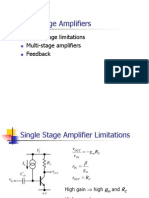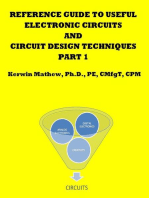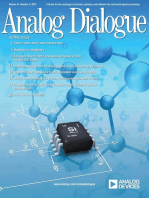Common-Emitter Amplifier High-Frequency Response: H - F R S BJT A
Common-Emitter Amplifier High-Frequency Response: H - F R S BJT A
Uploaded by
helenarajCopyright:
Available Formats
Common-Emitter Amplifier High-Frequency Response: H - F R S BJT A
Common-Emitter Amplifier High-Frequency Response: H - F R S BJT A
Uploaded by
helenarajOriginal Description:
Original Title
Copyright
Available Formats
Share this document
Did you find this document useful?
Is this content inappropriate?
Copyright:
Available Formats
Common-Emitter Amplifier High-Frequency Response: H - F R S BJT A
Common-Emitter Amplifier High-Frequency Response: H - F R S BJT A
Uploaded by
helenarajCopyright:
Available Formats
EEE 194RF Simple BJT Amps: High Frequency 1
HIGH-FREQUENCY RESPONSE OF SIMPLE BJT AMPLIFIERS
At high frequencies, the amplifier response is characterized by midband and high-frequency poles. Single BJ T
amplifiers are analyzed.
Common-emitter amplifier high-frequency response
AC model of a simple BJ T common-emitter amplifier is shown in Figure 1.
R
B
R
C
Q
1
R
S
v
o v
s
+
+
R
B
R
C
R
S
v
o
v
s
+ +
r
o
g
m
v
r
b
v
(a)
(b)
Figure 1. Common-Emitter Equivalent Circuits
(a) Midband AC Equivalent, (b) High-Frequency Equivalent
The input portion of the high-frequency equivalent circuit is simplified for analysis as shown in Figure 2.
R
C
R'
S
v
o
v
i
+ +
r
o
g
m
v
r
b
v
R
S
R
B
=
v
S
R
S
( ) R
S
R
B =
Figure 2. Simplified Input Portion of High-Frequency Equivalent Circuit
Miller's Theorem is used to simplify the high-frequency equivalent circuit made complex by the presence of C
which interconnects the input and output sections of the circuit.
The two-port network accentuated by the shaded area has a midband voltage gain of
( )
'
o
m o C m C
v
A g r R g R
v
= = = ,
which is used in Miller's Theorem,
1 2
1 1
Z AZ
Z Z
A A
= =
. (10.5-2)
General Linear
Network
V = A V
2 1 2 1
V V
Z
+ +
1i 2i
in out
General Linear
Network
V = A V
2 1 2 1
V V
+
Z Z
1 2
1s 2s in out
with
with
(a) (b)
Figure 3. Miller's Equivalent Circuits : (a) Interconnecting Impedance, (b) Port-Shunting Impedance
The use of Miller's Theorem results in the following equivalent circuit:
EEE 194RF Simple BJT Amps: High Frequency 2
R
C v
o
+
o
g
m
v
r
b
v
C
i C
'
R'
S
v
i
+
R
S
R
B
=
v
S
R
S
( ) R
S
R
B =
Figure 4. Miller's Theorem Applied to a Common-Emitter Amplifier
where
( )
( )
'
'
1
1 1
1
1
1
i m C
i
m C
j C
C C g R
j C A
j C g R
= = = +
and
( )
( )
'
'
' '
1
1
1 1
m C
m C
o
o m C m C
A
g R
j C
g R
C C
j C A g R j C g R
= = =
The voltage gain of the circuit is therefore:
'
'
1
1
1
o o i
V
S i s
S B i
m C
o S
S b
i
v v v v
A
v v v v
r
R R j C
g R
j C R
R r r
j C
| | | || || |
= =
| | | |
\ \ \ \
1
1
1 | | 1
1
=
1 |
1
1 |
| |
1 ] \ ]
1
+ +
|
1
\ ]
Simplifying this expression to yield an expression for the gain which clearly shows the poles of the amplifier:
( ) ( )
( )
'
'
'
1 1
1
1
m C B
V
S B b B b o C
i S b
g R R r
A
R R r r R r r j C R
j C r R r
1 1
=
` 1
1
+ + + + + 1
+ + ]
]
] )
The high frequency poles for the common-emitter amplifier as shown in Figure 1 are:
1 '
1
1
P
o C
j C R
=
+
and
( )
2
'
1
1
P
i S b
j C r R r
=
+ +
.
Simply put, the voltage gain characteristics of the amplifier at high frequencies is composed of the midband
voltage and the lowpass transfer characteristics of the input and output portions of the high-frequency equivalent
circuit:
[ ]
( )
'
'
1 1
1
1
V Vm
o C
i S b
A A
j C R
j C r R r
1
=
`
1
+ 1
+ + ]
] )
.
Common-collector amplifier high-frequency response
AC model of a simple BJ T common-collector amplifier is shown in Figure 5.
EEE 194RF Simple BJT Amps: High Frequency 3
R
B
R
C
Q
1
R
S
v
o
v
s
+
+
R
B
R
C
R
S
v
o
v
s
+
+
r
o
g
m
v
r
b
v
(a)
(b)
R
B
R
B
Figure 5. Common-Collector Equivalent Circuits
(a) Midband AC Equivalent, (b) High-Frequency Equivalent
The input portion of the high-frequency equivalent circuit is simplified for analysis as shown in Figure 6. For
simplicity, r
o
is considered to be very large compared to R
C
and R
E
.
R
C
v
o
+
+
g
m
v
r
b
v
R
B
R'
S
v
i
R
S
R
B
=
v
S
R
S
( ) R
S
R
B =
Figure 6. Simplified Input Portion of High-Frequency Equivalent Circuit
The gain of the shaded two-port network is ( )
ec
m C E
v
A g R R
v
= = + which is used in Miller's Theorem,
1 2
1 1
Z AZ
Z Z
A A
= =
. (10.5-2)
When Miller's Theorem is applied to the common-collector amplifier,
( ) 1
i m C E
C C C g R R
= + + +
and
( )
( )
1
m C E
O
m C E
g R R
C C C
g R R
+ +
=
+
with the equivalent circuit shown in Figure 7:
R
C
v
o
+
+
g
m
v
r
b
v
R
B
R'
S
v
i
R
S
R
E
=
v
S
R
S
( ) R
S
R
E =
C
Figure 7. Miller's Theorem Applied to a Common-Collector Amplifier
EEE 194RF Simple BJT Amps: High Frequency 4
The pole introduced by the C
i
is of primary interest since C
o
is less than the input capacitance.
Therefore, assume that the pole introduced by C
o
is sufficiently high so that C
o
can be replaced by an
open circuit.
The voltage gain of the common-collector amplifier is:
( ) ( )
'
' 1
o m E S
V
s S b m E i S b S
v g r R R
A
v R r g R r j C r R r R
=
+ + + + +
The dominant high-frequency pole is
( ) { }
1
1 1
1
1 1
P
S b S b
i m C E
m E m E
R r R r
C r C C g R R r
g R g R
=
1 1
| | | | + +
+ + + 1
1 1
| |
]
+ +
1 1 \ \
] ]
.
Common-emitter amplifiers with emitter resistors have the same basic topology as the common-collector
amplifier. The resultant pole location remains identical.
Common-base amplifier high-frequency response
AC model of a simple BJ T common-base amplifier is shown in Figure 8.
R
E
R
C
Q
1
R
S
v
o
v
s
+ +
R
E
R
C
R
S
v
o
v
i
+ +
g
m
v
r
b
v
(a)
(b)
R
B
C
B
v
s
R
E
R
S
R
S
=
R '
S
=
Figure 8. Common-Base Equivalent Circuits
(a) Midband AC Equivalent, (b) High-Frequency Equivalent
Note that there are no capacitors bridging the input and output terminals: therefore, there do not exist Miller
effect high valued capacitors. Therefore, the poles are at very high frequencies.
To simplify the analysis, assume that the base current is small so the voltage across r
b
is also small. Then r
b
can
be ignored: that is, let r
b
=0 and v
e
v
.
The poles are located at
( ) ( )
( )
1
1 '
'
m S E
F
P T
S E
r g r R R
C r C r R R
+ +
= = and
2
1
P
C
C R
= .
Both poles are at very high frequencies. Therefore, common-base amplifiers are not usually the frequency
limiting elements in a multistage amplifier.
You might also like
- LET Reviewer Professional Education SOCIAL DIMENSIONS Questionnaire Part 1Document10 pagesLET Reviewer Professional Education SOCIAL DIMENSIONS Questionnaire Part 1odelle100% (6)
- 2 Wien Bridge OscillatorDocument1 page2 Wien Bridge OscillatorcpburkNo ratings yet
- Bipolar Junction Transistors - III (Bjt-Iii) Analyzing Transistor AmplifiersDocument34 pagesBipolar Junction Transistors - III (Bjt-Iii) Analyzing Transistor AmplifiersDikshant KanojiaNo ratings yet
- Esercitazione amp-BJT - PpsDocument22 pagesEsercitazione amp-BJT - PpsLuckyLuke981No ratings yet
- Small-Signal Modeling and Linear AmplificationDocument30 pagesSmall-Signal Modeling and Linear AmplificationTaufique ZamanNo ratings yet
- RF Electronic Preparatory Ii: Amplifier and Filter Laboratory ExerciseDocument12 pagesRF Electronic Preparatory Ii: Amplifier and Filter Laboratory ExercisesvinqtaNo ratings yet
- Small-Signal Modeling and Linear AmplificationDocument30 pagesSmall-Signal Modeling and Linear AmplificationMohammad Gulam AhamadNo ratings yet
- Publication 12 4697 82Document9 pagesPublication 12 4697 82Mariam AznabetNo ratings yet
- Electronic Circuits - Unit - 2 - MCQDocument4 pagesElectronic Circuits - Unit - 2 - MCQShivani AndhaleNo ratings yet
- Chapter 1Document18 pagesChapter 1mustafaasaad020No ratings yet
- Phase Shift OscillatorDocument31 pagesPhase Shift OscillatorArjob MukherjeeNo ratings yet
- Chapter 9Document18 pagesChapter 9Abhinav GuptaNo ratings yet
- Lec2 Frequency ResponseDocument79 pagesLec2 Frequency ResponseAli AhmadNo ratings yet
- BJT Small SignalDocument56 pagesBJT Small SignalMohammad Gulam AhamadNo ratings yet
- Common - Emitter Amplifier 3.1.1 ObjectiveDocument5 pagesCommon - Emitter Amplifier 3.1.1 ObjectiveQaim RazaNo ratings yet
- How To Bias Bjts For Fun and Profit: Standard BJT Biasing ConfigurationDocument12 pagesHow To Bias Bjts For Fun and Profit: Standard BJT Biasing ConfigurationskyghNo ratings yet
- 05 BJT-Amplifiers PDFDocument40 pages05 BJT-Amplifiers PDFMd ArifNo ratings yet
- EMT 212/4: Analogue Electronic IIDocument41 pagesEMT 212/4: Analogue Electronic IIdev_mathanNo ratings yet
- BJT Small SignalDocument58 pagesBJT Small SignalMark David Abin ValgunaNo ratings yet
- Guide ElectronicsDocument9 pagesGuide ElectronicsIsha MancenidoNo ratings yet
- Chapter - 4single Stage IC Amplifier (For IT Class)Document85 pagesChapter - 4single Stage IC Amplifier (For IT Class)Rajesh BathijaNo ratings yet
- Lecture21 Multistage AmplifiersDocument10 pagesLecture21 Multistage Amplifierscitraumari100% (1)
- Common Emitter Transistor Common Emitter Transistor Amplifier AmplifierDocument9 pagesCommon Emitter Transistor Common Emitter Transistor Amplifier AmplifierMauro FernandoNo ratings yet
- Answer KeyDocument0 pagesAnswer Keyfabri4No ratings yet
- Single Stage Limitations Multi-Stage Amplifiers FeedbackDocument17 pagesSingle Stage Limitations Multi-Stage Amplifiers FeedbackJoshua DuffyNo ratings yet
- 3 AC AmplificationDocument58 pages3 AC AmplificationAnthony BeltranNo ratings yet
- 2020 FinalDocument3 pages2020 FinalBen ChouNo ratings yet
- Chapter 1: Op-Amps: I. Practical Op-AmpDocument11 pagesChapter 1: Op-Amps: I. Practical Op-Amprockrockyrocker123No ratings yet
- BJT Single Stage CE AmplifierDocument10 pagesBJT Single Stage CE AmplifierVăn Công100% (1)
- Wein Bridge Oscillators PresentationDocument15 pagesWein Bridge Oscillators PresentationHarish KumarNo ratings yet
- Unti 4Document29 pagesUnti 4dhruvkareliya1004No ratings yet
- Chapter 7 Amplifier Frequency Response PDFDocument32 pagesChapter 7 Amplifier Frequency Response PDFVijaykumarPatilNo ratings yet
- Frequecny Response of Lag NetworkDocument4 pagesFrequecny Response of Lag NetworkAnbalagan GuruNo ratings yet
- Analog Circuits Unit 1 FormulaeDocument15 pagesAnalog Circuits Unit 1 FormulaeRaviNo ratings yet
- Analog Communication Laboratory Report: Department of Electronics and Communication EngineeringDocument19 pagesAnalog Communication Laboratory Report: Department of Electronics and Communication EngineeringArjun PurushothamanNo ratings yet
- Satyam Kr. Tiwari 99, EC&D PracticalDocument8 pagesSatyam Kr. Tiwari 99, EC&D Practicalvkbwqzgb9mNo ratings yet
- JollyGS Design Simulation and Characterisation of A Class-B Audio Power AmplifierDocument31 pagesJollyGS Design Simulation and Characterisation of A Class-B Audio Power AmplifierMortenGundersenNo ratings yet
- Operational AmplifiersDocument12 pagesOperational AmplifiersShachi P GowdaNo ratings yet
- Unit 1 AmplifiersDocument46 pagesUnit 1 Amplifiersvimalaspl7831No ratings yet
- Chapter 13 Linear Amplifiers BJT-1-1Document31 pagesChapter 13 Linear Amplifiers BJT-1-1doubleagent93No ratings yet
- Feedback Amplifiers: Basic Description of FeedbackDocument19 pagesFeedback Amplifiers: Basic Description of FeedbackMoslem FouadNo ratings yet
- 9 - E3-OsciladorDocument44 pages9 - E3-OsciladorMiguel LoderoNo ratings yet
- Lab 3Document6 pagesLab 3Saurabh BhiseNo ratings yet
- Solns - 1 CmosDocument15 pagesSolns - 1 Cmosramprakash_rampelliNo ratings yet
- Cascode AmplifierDocument6 pagesCascode AmplifierRajesh NatarajanNo ratings yet
- Common Emitter Amplifier: S.No Name of The Component/ Equipment Specifications QtyDocument0 pagesCommon Emitter Amplifier: S.No Name of The Component/ Equipment Specifications Qtyagama1188No ratings yet
- Experiment No6Document8 pagesExperiment No6alaaNo ratings yet
- BJT3 BJT Amplifiers All ConfigurationsDocument23 pagesBJT3 BJT Amplifiers All ConfigurationsJanko JaridicNo ratings yet
- End Term E3 238Document6 pagesEnd Term E3 238bommena vishwa tejaNo ratings yet
- Experiment.3.SingleTunedAmp 22112016Document12 pagesExperiment.3.SingleTunedAmp 22112016Saurav kumarNo ratings yet
- Reference Guide To Useful Electronic Circuits And Circuit Design Techniques - Part 2From EverandReference Guide To Useful Electronic Circuits And Circuit Design Techniques - Part 2No ratings yet
- Reference Guide To Useful Electronic Circuits And Circuit Design Techniques - Part 1From EverandReference Guide To Useful Electronic Circuits And Circuit Design Techniques - Part 1Rating: 2.5 out of 5 stars2.5/5 (3)
- Analog Dialogue, Volume 48, Number 1: Analog Dialogue, #13From EverandAnalog Dialogue, Volume 48, Number 1: Analog Dialogue, #13Rating: 4 out of 5 stars4/5 (1)
- Exercises in Electronics: Operational Amplifier CircuitsFrom EverandExercises in Electronics: Operational Amplifier CircuitsRating: 3 out of 5 stars3/5 (1)
- Easy(er) Electrical Principles for Extra Class Ham License (2012-2016)From EverandEasy(er) Electrical Principles for Extra Class Ham License (2012-2016)No ratings yet
- Fundamentals of Electronics 1: Electronic Components and Elementary FunctionsFrom EverandFundamentals of Electronics 1: Electronic Components and Elementary FunctionsNo ratings yet
- FormulaDocument7 pagesFormulahelenarajNo ratings yet
- Fiber Sensors ReviewDocument12 pagesFiber Sensors ReviewhelenarajNo ratings yet
- Fiber Sensor SystemDocument138 pagesFiber Sensor SystemhelenarajNo ratings yet
- Vallarai KeeraiDocument2 pagesVallarai KeeraihelenarajNo ratings yet
- Fiber-Optic Sensors:: Applications and AdvancesDocument6 pagesFiber-Optic Sensors:: Applications and AdvanceshelenarajNo ratings yet
- Photonic CrystalDocument11 pagesPhotonic CrystalhelenarajNo ratings yet
- 06 - Chapter 1 PDFDocument16 pages06 - Chapter 1 PDFhelenarajNo ratings yet
- Introduction On Satellite CommunicationDocument35 pagesIntroduction On Satellite CommunicationhelenarajNo ratings yet
- Electronic Instrumentation: Experiment 4Document63 pagesElectronic Instrumentation: Experiment 4helenarajNo ratings yet
- Ec2254-Linear Integrated Circuits Unit-IDocument3 pagesEc2254-Linear Integrated Circuits Unit-IhelenarajNo ratings yet
- Saw-Tooth Wave Generator Circuit DiagramDocument4 pagesSaw-Tooth Wave Generator Circuit DiagramhelenarajNo ratings yet
- EC303 - Linear Integrated CircuitsDocument123 pagesEC303 - Linear Integrated CircuitshelenarajNo ratings yet
- Unit 2: Introduction To Operational AmplifiersDocument14 pagesUnit 2: Introduction To Operational AmplifiershelenarajNo ratings yet
- Function Generator Ic 8038Document5 pagesFunction Generator Ic 8038helenarajNo ratings yet
- Chapter 17Document66 pagesChapter 17helenarajNo ratings yet
- Notes On The "Butcher and Cotter Convention" in Nonlinear OpticsDocument2 pagesNotes On The "Butcher and Cotter Convention" in Nonlinear OpticshelenarajNo ratings yet
- New Microsoft Office Word DocumentDocument6 pagesNew Microsoft Office Word DocumenthelenarajNo ratings yet
- Electro Magnetic FieldsDocument6 pagesElectro Magnetic FieldshelenarajNo ratings yet
- GPS Antenna Primer: Improve Your Navigation: The Reasons To Need An External GPS AntennaDocument2 pagesGPS Antenna Primer: Improve Your Navigation: The Reasons To Need An External GPS AntennahelenarajNo ratings yet
- Microwave Tube Principles: Neets To Electronic Emission, Tubes, and Power SuppliesDocument5 pagesMicrowave Tube Principles: Neets To Electronic Emission, Tubes, and Power SupplieshelenarajNo ratings yet
- Ece 3sem 147302nolDocument98 pagesEce 3sem 147302nolhelenarajNo ratings yet
- ETABS & STAAD ComparisonDocument70 pagesETABS & STAAD Comparisonpido290% (1)
- VernacularArchitecture EasternCape Doc FINAL4Document16 pagesVernacularArchitecture EasternCape Doc FINAL4BlackFlix Legendas em PortuguêsNo ratings yet
- JkggfhhhyDocument51 pagesJkggfhhhyKimberly ValsoteNo ratings yet
- 0719 Col Packaging PDFDocument3 pages0719 Col Packaging PDFBechir OuhibiNo ratings yet
- EGCSE First Language SiSwati 2022 Exminer ReportDocument39 pagesEGCSE First Language SiSwati 2022 Exminer ReportFisiwe MasekoNo ratings yet
- G&H Products - RF Drivers For Acousto-Optic Devices - A35xxx-S-1 - 50-P4k7uDocument7 pagesG&H Products - RF Drivers For Acousto-Optic Devices - A35xxx-S-1 - 50-P4k7uRatnesh BafnaNo ratings yet
- Artificial Intelligent Operating System (AIOS) : PRESENTED BY: Ubaidullah Roll# (15892) Mscs IiDocument17 pagesArtificial Intelligent Operating System (AIOS) : PRESENTED BY: Ubaidullah Roll# (15892) Mscs Iiamina nawazNo ratings yet
- MB Clean ResultsDocument13 pagesMB Clean ResultsVictorIoncuNo ratings yet
- Gear Inspection Machine, Osaka Seimitsu Kikai, Gear Measuring Instruments, Gear Checkers, Gear TestersDocument7 pagesGear Inspection Machine, Osaka Seimitsu Kikai, Gear Measuring Instruments, Gear Checkers, Gear TestersinvolutegearNo ratings yet
- Types of Audience:: Primary Audience: The Primary Audience Is The Audience Who Have To DecideDocument2 pagesTypes of Audience:: Primary Audience: The Primary Audience Is The Audience Who Have To DecideShalini RaiNo ratings yet
- Wardrobe DesignsDocument7 pagesWardrobe DesignspbariarNo ratings yet
- Datasheet Transducer Dong Dien - Dien ApDocument2 pagesDatasheet Transducer Dong Dien - Dien ApChương Hoàng KhaNo ratings yet
- Food Ordering System in CDocument38 pagesFood Ordering System in CNG COMPUTERNo ratings yet
- Design of A Three Phase Squirrel Cage Induction Motor For Electric Propulsion SystemDocument6 pagesDesign of A Three Phase Squirrel Cage Induction Motor For Electric Propulsion SystemBahi EzioNo ratings yet
- Camera Request Form: Material ListsDocument2 pagesCamera Request Form: Material ListsGirma Abebe BNo ratings yet
- Eclectic CounselingDocument2 pagesEclectic CounselingKen Paul BalcuevaNo ratings yet
- 13 Adhesión Baypren ArlanxeoDocument2 pages13 Adhesión Baypren ArlanxeoCalidad Cauchos VikingoNo ratings yet
- 2DG & 2 SOLAR-nugal WaterDocument1 page2DG & 2 SOLAR-nugal WaterMajeed aliNo ratings yet
- Relative ClausesDocument3 pagesRelative ClausesMuhammad Imran QureshiNo ratings yet
- 01 - System Overview V2Document8 pages01 - System Overview V2Mario NấmNo ratings yet
- Bumble Value Proposition CanvasDocument2 pagesBumble Value Proposition CanvasNaveen ThirukumaranNo ratings yet
- 11 - Tata Power Safety Document Control ProcedureDocument15 pages11 - Tata Power Safety Document Control Procedureloganathan100% (1)
- 08 Adhoc Sensitivity AnalysisDocument8 pages08 Adhoc Sensitivity AnalysisUdhav JoshiNo ratings yet
- From Local To Global: A Graph RAG Approach To Query-Focused SummarizationDocument15 pagesFrom Local To Global: A Graph RAG Approach To Query-Focused SummarizationHari PrasadNo ratings yet
- Framework Design GuidelinesDocument7 pagesFramework Design GuidelinesKavitha Nistala GollapudiNo ratings yet
- How Can One Become A Successful Option ScalperDocument18 pagesHow Can One Become A Successful Option ScalperlambazNo ratings yet
- Installation Instructions Model HZM: Remote Conventional Zone ModuleDocument8 pagesInstallation Instructions Model HZM: Remote Conventional Zone ModuleTelecom OperacionesNo ratings yet
- Incident Investigation Report of Hydraulic Oil SpillDocument4 pagesIncident Investigation Report of Hydraulic Oil SpillSj YoungNo ratings yet
- Gurong Pinoy International Social Science MajorDocument5 pagesGurong Pinoy International Social Science MajorShane BellenNo ratings yet














































































































